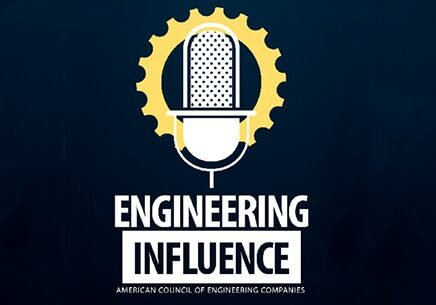
Episode Details
A rundown of the Q2 2019 Business Update.
Announcer: 00:00 Last week, ACEC released its second quarter engineering business index survey or firm leaders. Gerry, what update do you have for us?
Gerry Donohue: 00:15 Well, the survey which is known in the industry as the EBI edged up slightly by 0.4 points to 62.6.
Announcer: (00:23) So a 62.6 score. What does that mean?
Gerry Donohue: (00:25) The EBI is a diffusion index in which the responses of about 200 firm leaders to more than a dozen questions about the business market and financial performance of their firms are distilled down to a single number. A number above 50 signifies business expansion. All scores below 50 indicate contraction.
Announcer: 00:46 How does this score compare to past scores?
Gerry Donohue: 00:48 We’ve been doing the EBI for about six and a half years and it has moved in a relatively narrow band or my high of 68.9 in the second quarter of 2014 to a low of 58.5 in the fourth quarter of 2018 that pretty accurately tracks the market.
Gerry Donohue: 01:04 Over that period, business has generally been good for engineering firms and respondents. Concerns have focused on forces that create uncertainty. In the marketplace. For instance, the survey low in the fourth quarter of 2018 was due largely to worries about what tariffs and the trade war could do to the domestic market.
Announcer: 01:20 What are some of the other highlights?
Gerry Donohue: 01:22 Profitability and backlog are the big drivers in the Ebi and they reflect near term concerns, but long-term optimism, respondents expectations for firm profitability over the next three months and the next six months declined. But they’re optimistic about increased profitability three years from now. Likewise, they reported that their backlogs have shrunk, but they expect them to grow over the next 12 months, which then feeds into those increased profitability expectations.
Announcer: 01:49 So we do ask questions about market sector. What do the private and public market sectors, what are they looking for?
Gerry Donohue: 01:56 Well, in the private sector, which is the, which accounts for about 80% of all construction firm leaders, expectations are mixed. They expect to see the industrial manufacturing education and land development sectors increase, but they’re less optimistic about the energy and power, healthcare and building sectors and the public markets. They were more optimistic with five of the six sectors expected to improve. They said that the environmental sector and the building sector will improve the most followed by transportation, education and water and wastewater. They expect the healthcare sector to be flat.
Announcer: 02:29 You’ll also ask firms to report on the impact of the 2017 tax cuts and jobs act. What are they saying?
Gerry Donohue: 02:35 Well, it’s been over a year since the law took effect. It lowered the corporate tax rate from 35% to 21% and due in large part to ACEC lobbying created a new 20% tax deduction for pass through entities such as s corporations, partnerships and sole proprietorships.
Gerry Donohue: 02:51 More than a quarter of the respondents credited the new law with improving their bottom line. One said it was absolutely the right thing for business growth. While it’s been made hiring harder and wages have gone up, profits have gone up as well. They also said that they’ve been able to increase investment in their firms. One firm leaders said that the lower tax rate incentivized his firm to retain more earnings and to improve their balance sheet. Other responses include, they’ve made new hires, they’ve grown their firm, and they’ve increased the value of their employee stock ownership programs. Something to note though, while almost all the comments on the new law were positive, several firm leaders were critical citing the subsequent rise in the federal budget deficits. One said the tax cut looks good in short term, but ultimately it’s a terrible idea.
Announcer: 03:34 And you also ask from leaders about their biggest challenges of running an engineering firm. What did you learn?
Gerry Donohue: 03:40 Well, not surprisingly, more than 52% said that recruiting and retaining top talent is their biggest task. One said that they helped the economy and a talented high achieving, self-focused young workforce. Employee retention sits at the top of his worry list. Second was onerous contract demands from clients and owners. One firm leader said that clients increasingly viewing engineering services as a commodity and his firm constantly has to prove its value. Other challenges, we’re distinguishing the firm from the competition, generating a suitable backlog, slow paying clients, and burdensome government regulations.
Announcer: 04:13 That’s very interesting. So how do our members find the report?
Gerry Donohue: 04:17 Well, if you want to read the full report and look at the numbers behind the index, go to www.acec.org and scroll down to the engineering business index link.
Announcer: 04:26 That’s great. So we look forward to your next update, Jerry, and thank you for coming in.
Sponsor
ACEC
Date
July 25, 2019






